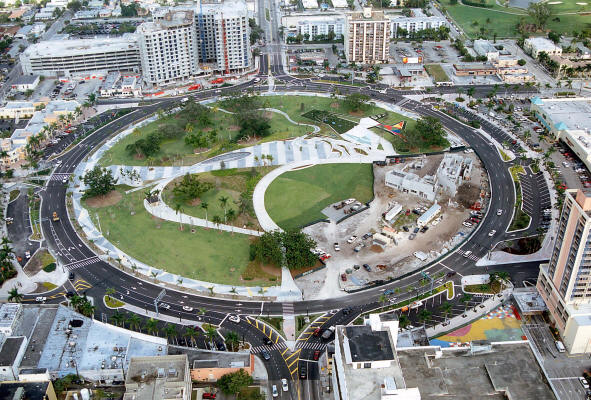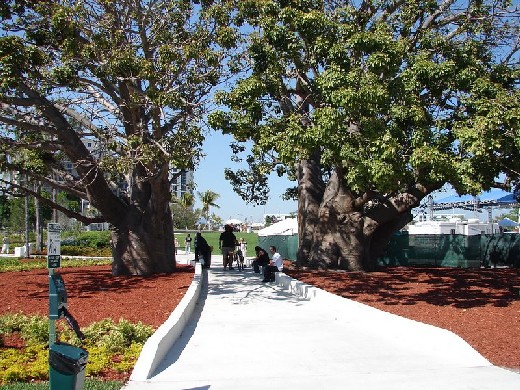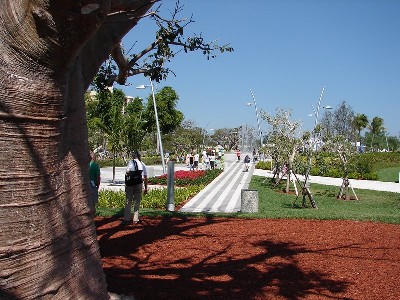Florida is hot (not hip) and humid (sensual too.). To succeed outside, the designer must know where the sun is all times and how best to find some breeze. These are very serious issues for the success of any outdoor space away from the beach. Together with the extra water that feeds the more luscious plants and trees than the other Hollywood, the careful designer can use nature to tweak – a little – the dominant globalism of placemaking. Tweaking is all we can expect. Globalism has won ( or one).
Click here for first part of essay. Click here for photographs of park.
Both park designer Margi Glavovic Nothard and public artist Ritsuko Taho follow this instinct of tweaking globalism for the specific place. They both are attracted to the tree, the big tree, the giant baobabs from Africa. The baobab requires a non-freezing, wet-dry annual cycle that is shared by its native southeast Africa / Madagascar and its adoption in southeast Florida. The tweaking began when Joseph Young founded Hollywood and planted the baobab primarily to just fill-up the empty 14 acres of grass.

The thoughtless filling of Young Circle was completed with other non-native giants: figus and the royal poinciana. The figus has a luscious, dense green top and many trunks that can reach 30 feet across. The muscular branches of the royal poinciana reach out like static worms and shower the eye with scarlet color in the summer. These giant trees, planted from the 1920 to the 1960s, plus native sabal palms and vast diversity of evergreen scrubs and groundcovers, are the palette of the Florida retirement look. It is now being lost.
After the crushing hurricanes of 2004 & 2005, especially Wilma, the cities and counties are encouraging native and other trees that might have better hurricane resistance. The luscious green view with it annual energized flowering will be replaced with a gray-green stability more common in Houston or Savannah. Strangely, Glavovic Nothard allowed the invading Live Oak to be planted in the park. Perhaps, 12 months after Wilma, she had no choice.
Glavovic Nothard stated in her public tour of the park on March 17, 2007, that after she decided to make the vast shallow hill, the hill had to be carefully modified to preserve the original ground level at the base of the trees. Only two trees were transplanted.
Looking around it becomes clear that the park is an encounter with these trees. A bridge spans the roots of the double baobabs guarding the park’s entry from the south. Like all great bridges, it invents a movement of passage. Instead of the view down the river, it celebrates the trunks and speckled shade. People stop and sit. Stand and view. As is frequent in Glavovic Nothard’s design, the zone is both passage and place.

In the northwest quadrant, the trees make a zone of shaded grass. This zone existed before, but very few people ever used it. Glavovic Nothard’s design guides people on narrow ribbon paths or wide river walkways to be near, but not touching, the trees. This distancing allows each tree to have its own space that overlooks the path. A rhythm develops of people partnering with each tree shade space. One tree, one family.
I don’t know the artistic interaction of Taho and Glavovic Nothard, but the marriage is seamless. Not because of visual consistency, but due to the conceptual grounding of the park in the rhythm of tree and path. Taho’s work is the poetic consolidation of Glavovic Nothard’s plan. In my mind, this is the perfect collaboration sought for 25 years since the first artist-architect collaboration in contemporary public art: Viewland Hoffman Electrical Substation, Seattle, 1979.
Taho’s “Millennium Springs” centers around the largest baobab and transforms its “biorhythm” into visual motion and sound. From the published information, I could not understand what she “recorded” in the tree. Intensity of electromagnetic waves? If os, what causes them? Does a healthy tree have a different pattern from a sick one? What about dry seasons and wet seasons? All interesting questions left unanswered.
With all artworks, we must release ourselves into the believable imaginary world of the artwork. Given that science is our verifier of truth, Taho’s scientific measurement of the biorhythm pushes me over the tipping point into the believability. Even with the science, the “suspension of disbelief” will only function for those that have already let themselves feel the powerful forces in plants, so obvious in the spring.
Taho draws the dream pattern of Hollywood founder, Joseph Young, emanating from his bronze head. Here the dream pattern is a “typical” REM sleep wave. Although lovely in the concrete with the little shells, I find the ground drawing an uninspired narrative that is so frequent in public art today. I cannot find any imaginary world to enter. Just an idea that Mr. Young had a dream. Unfortunately for him, a dream that drove him into bankruptcy.
With the baobab, Taho constructs a multiplicity of senses and images that let my mind and body wander across her imagination. The biorhythms are remade in two forms: 1. sounds of “new age” slowly blending tones that equally surround the tree. 2. a moving graph of water made by 72 feet of computer controlled water jets. Both the tones and water merge with the two other dominate wave-patterned sounds: automobile engineers and wind in the leaves. For a work to be convincing, it must merge with the reality of the place.

In her drawing, Taho’s site plan looks like a string instrument with the tree as the sound chamber, the fountain as the tuning keys and a concrete path as the strings. On the ground, the concrete path has the same four white spaces as the “staff” on sheet music. In perspective from the tree, the water jets appear like musical notes running up and down the staff. Music with song and dance is the way we humans know the rhythm of ourselves and then the rhythms of the others like the tree.
(The City of Hollywood should invite Ellen Fullman, inventor the long string instrument, to play the space. That might over do it)
Regarding the fountain, most computer-controlled fountains have big breaks and total change: No water. All water. Every third jet. A mathematical run. Taho’s pattern is like a slow wave. More like watching the ocean or a stream. Calming with predictable fluctuations. It is the pattern of a healthy biology, and therefore hopeful.
None of Taho’s work is possible without Glavovic Nothard. Even Taho’s final elegant touch, a Japanese ceremonial rope tied high around the trunk, requires Glavovic Nothard’s equally clearheaded knowledge of the value of these trees and how to make space for each one. The shallow hill provides the effortless manner to make an object of the fountain. The fountain is placed as the final event “on the way” to the top of the hill. Like FL Wright, Glavovic Nothard imbeds the visual elements and places in crest of the hill and then leaves the top for the wind and the sky.
This brings us back to how nature contributes to Glavovic Nothard’s local globalism. The main gathering place is the top of the hill because we must have breeze to gather together. The amphitheater seating faces the winds from the southeast and cuts the edge off the early evening sun during the concerts. The nearly complete arts center runs the central breezeway east-west because the length of outdoor hall blocks the hot rays of the east and west sun.
These are the details of place. So hard to communicate internationally. So hard to know without years living and observing in the same geography. So valuable for the bodily connecting to the earth in our time of exciting virtual exploration.
Public Art, Public Space
